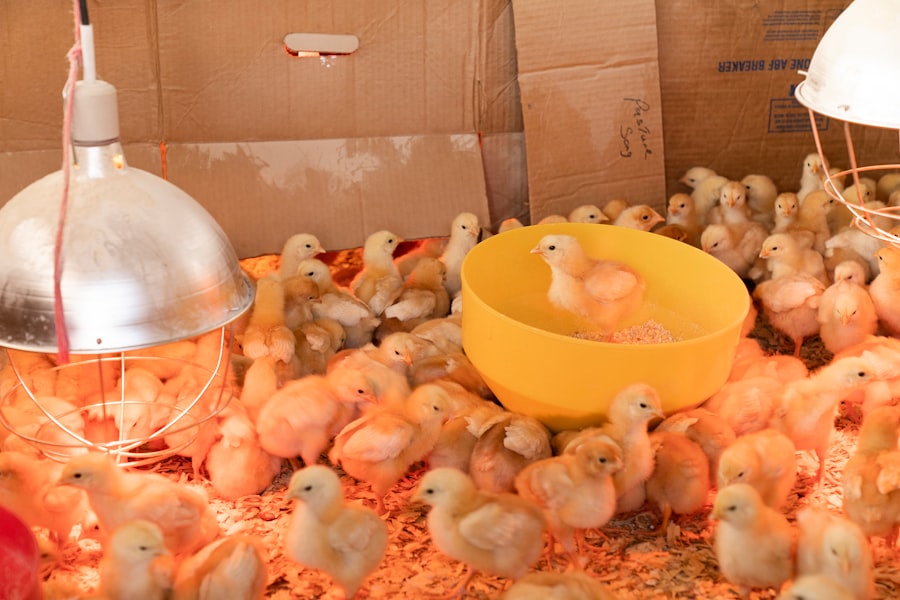Keeping turkeys and chickens together in the same coop is a topic that many poultry enthusiasts have debated over the years. While there are some challenges to consider, it is possible for these two species to coexist harmoniously with proper planning and care. In this article, we will explore the benefits and considerations of keeping turkeys and chickens together, as well as provide tips for successfully housing them in the same coop.
One of the main benefits of keeping turkeys and chickens together is reduced space requirements. By housing them together, you can save on the cost and space needed for separate coops. Additionally, keeping them together allows for increased socialization between the two species, which can have positive effects on their overall well-being.
However, there are also important considerations to keep in mind before deciding to house turkeys and chickens together. Turkeys are generally larger and more aggressive than chickens, which can lead to potential conflicts. It is crucial to understand the physical and behavioral differences between these two species in order to create a safe and harmonious living environment for both.
Key Takeaways
- Turkeys and chickens can coexist in the same coop with proper planning and care.
- Turkeys and chickens have different needs and behaviors that should be understood before keeping them together.
- Keeping turkeys and chickens together can provide benefits such as pest control and social interaction.
- Considerations such as space, roosting areas, and feeding should be taken into account before keeping turkeys and chickens together.
- A well-designed coop plan and maintenance routine can ensure a clean and healthy environment for both turkeys and chickens.
Understanding the Differences Between Turkeys and Chickens
Turkeys and chickens have distinct physical and behavioral differences that can affect their cohabitation. Turkeys are larger birds, with adult males weighing up to 30 pounds or more, while chickens typically weigh between 4-8 pounds. This size difference can lead to potential dominance issues if not properly managed.
In terms of behavior, turkeys are known to be more aggressive than chickens. They have a strong pecking order and may exhibit territorial behavior towards other birds, including chickens. Chickens, on the other hand, are generally more docile and submissive. They tend to establish a clear hierarchy within their flock but are less likely to engage in aggressive behavior towards other species.
These differences in size and behavior mean that special considerations must be taken when housing turkeys and chickens together. Providing enough space, separate roosting areas, and proper supervision are essential to ensure the well-being of both species.
Benefits of Keeping Turkeys and Chickens Together
Despite the challenges, there are several benefits to keeping turkeys and chickens together. One of the main advantages is reduced space requirements. By housing them together, you can save on the cost and space needed for separate coops. This can be especially beneficial for small-scale poultry keepers who have limited space available.
Another benefit is increased socialization. Turkeys and chickens are social animals that thrive in the presence of others. By keeping them together, you provide them with companionship and mental stimulation. This can have a positive impact on their overall well-being and reduce the risk of behavioral issues such as feather picking or aggression.
Additionally, keeping turkeys and chickens together can help with pest control. Turkeys are known to be excellent foragers and can help keep insect populations in check. Chickens also contribute to pest control by eating insects and other small pests. By combining these two species, you can create a natural pest control system that benefits both birds and your garden.
Considerations Before Keeping Turkeys and Chickens Together
Before deciding to house turkeys and chickens together, there are several important factors to consider. First and foremost, you need to assess the size and temperament differences between these two species. Turkeys are larger and more aggressive than chickens, which can lead to potential conflicts if not properly managed.
It is crucial to provide enough space for both turkeys and chickens to avoid overcrowding. Turkeys require more space than chickens due to their larger size and more active nature. A general rule of thumb is to provide at least 10 square feet per turkey and 4 square feet per chicken in the coop.
Another consideration is the compatibility of their diets. While turkeys and chickens can eat similar types of feed, turkeys have higher protein requirements. It is important to ensure that both species are receiving the appropriate nutrition for their specific needs. Providing separate feeding stations can help prevent competition and ensure that each bird gets the right amount of food.
Lastly, it is important to monitor the behavior of both turkeys and chickens when housed together. Aggression or bullying can occur, especially during feeding time or when establishing a pecking order. If any bird shows signs of distress or injury, it may be necessary to separate them to prevent further harm.
Choosing the Right Chicken Coop for Both Turkeys and Chickens
When housing turkeys and chickens together, it is important to choose a chicken coop that can accommodate both species’ needs. The coop should be spacious enough to provide adequate room for both turkeys and chickens to move around comfortably.
Proper ventilation is also crucial in a coop that houses both turkeys and chickens. Turkeys are more susceptible to respiratory issues, so good airflow is essential to prevent the buildup of ammonia and other harmful gases. Make sure the coop has windows or vents that can be opened or closed as needed to regulate temperature and air quality.
Insulation is another important feature to consider, especially if you live in an area with extreme temperatures. Turkeys are more sensitive to cold weather than chickens, so providing insulation can help keep them warm during the winter months. Insulating the coop walls and roof can help maintain a comfortable temperature year-round.
Designing a Chicken Coop Plan for Turkeys and Chickens

When designing a coop plan for turkeys and chickens, there are several factors to consider. First, it is important to provide separate nesting boxes for each species. Turkeys prefer to nest on the ground, while chickens prefer elevated nesting boxes. By providing separate nesting areas, you can ensure that each bird has a comfortable and secure place to lay their eggs.
Roosting areas should also be designed with the size and behavior of both turkeys and chickens in mind. Turkeys prefer to roost on low branches or platforms, while chickens prefer elevated roosts. Providing separate roosting areas can help prevent conflicts and ensure that each bird has a safe and comfortable place to rest.
Additionally, it is important to consider the accessibility of food and water for both species. Turkeys require larger waterers and feeders than chickens due to their larger size. Providing separate feeding and watering stations can help prevent competition and ensure that each bird has access to an adequate supply of food and water.
Providing Adequate Space and Roosting Areas for Both Turkeys and Chickens
Providing enough space is crucial when housing turkeys and chickens together. Turkeys require more space than chickens due to their larger size and more active nature. A general rule of thumb is to provide at least 10 square feet per turkey and 4 square feet per chicken in the coop.
In addition to space requirements, it is important to provide adequate roosting areas for both species. Turkeys prefer to roost on low branches or platforms, while chickens prefer elevated roosts. By providing separate roosting areas, you can prevent conflicts and ensure that each bird has a safe and comfortable place to rest.
It is also important to consider the height of the roosts. Turkeys are larger and heavier than chickens, so their roosts should be lower to the ground to prevent injuries from jumping or falling. Chickens, on the other hand, can have higher roosts that allow them to feel safe and secure.
Feeding and Watering Turkeys and Chickens Together
Feeding turkeys and chickens together requires careful consideration of their dietary needs. While they can eat similar types of feed, turkeys have higher protein requirements than chickens. It is important to provide a balanced diet that meets the specific nutritional needs of each species.
One option is to feed a higher protein feed to both turkeys and chickens. This can be achieved by providing a turkey-specific feed that meets their protein requirements, while also ensuring that chickens receive enough protein for their needs. Another option is to provide separate feeding stations for each species, with appropriate feed for their specific needs.
Watering turkeys and chickens together also requires some planning. Turkeys require larger waterers than chickens due to their larger size. It is important to provide enough waterers to ensure that each bird has access to an adequate supply of clean water. Separate waterers can help prevent competition and ensure that each bird gets enough water.
Maintaining a Clean and Healthy Environment for Both Turkeys and Chickens
Maintaining a clean and healthy environment is crucial when housing turkeys and chickens together. Regular cleaning of the coop is essential to prevent the buildup of waste and the spread of disease. Remove soiled bedding, droppings, and any other debris on a regular basis to keep the coop clean and odor-free.
It is also important to provide proper ventilation in the coop to prevent the buildup of ammonia and other harmful gases. Good airflow helps maintain air quality and reduces the risk of respiratory issues, especially in turkeys who are more susceptible to respiratory problems.
Preventing the spread of disease is another important aspect of maintaining a healthy environment. Quarantine new birds before introducing them to the existing flock to prevent the spread of any potential diseases. Regularly monitor the health of all birds and consult with a veterinarian if any signs of illness or distress are observed.
Successfully Keeping Turkeys and Chickens Together in One Coop
In conclusion, it is possible to keep turkeys and chickens together in the same coop with proper planning and care. While there are challenges to consider, such as size and temperament differences, the benefits of housing them together can outweigh the difficulties.
Reduced space requirements, increased socialization, and natural pest control are some of the benefits of keeping turkeys and chickens together. However, it is important to provide enough space, separate roosting areas, and proper supervision to ensure the well-being of both species.
By choosing the right chicken coop, designing a coop plan that accommodates both turkeys and chickens, providing adequate space and roosting areas, and maintaining a clean and healthy environment, you can successfully keep turkeys and chickens together in one coop. With proper planning and care, these two species can coexist harmoniously and provide enjoyment for poultry enthusiasts.
If you’re considering keeping turkeys and chickens together, it’s important to understand the dynamics and requirements of both species. While they can coexist in the same space, there are certain considerations to keep in mind. In a helpful article by Poultry Wizard, they discuss the topic of keeping turkeys and chickens together and provide valuable insights on how to successfully manage their cohabitation. The article explores factors such as coop size, feeding requirements, and potential challenges that may arise. To learn more about this topic, check out the article here.
FAQs
Can I keep turkeys and chickens together?
Yes, it is possible to keep turkeys and chickens together in the same coop or pen.
What are the benefits of keeping turkeys and chickens together?
Keeping turkeys and chickens together can help to reduce the risk of predation, as the turkeys are larger and can help to protect the chickens. Additionally, they can share the same living space and resources, which can be more convenient for the owner.
What are the potential problems of keeping turkeys and chickens together?
Turkeys and chickens have different dietary needs, so it is important to ensure that they are both receiving the appropriate nutrition. Additionally, turkeys can be more aggressive than chickens, so it is important to monitor their behavior and separate them if necessary.
What should I consider before keeping turkeys and chickens together?
Before keeping turkeys and chickens together, it is important to consider the size of the coop or pen, as well as the number of birds that will be living together. Additionally, it is important to ensure that the birds are receiving appropriate nutrition and that their behavior is monitored closely.
Can turkeys and chickens interbreed?
No, turkeys and chickens cannot interbreed as they are different species.
Meet Walter, the feathered-friend fanatic of Florida! Nestled in the sunshine state, Walter struts through life with his feathered companions, clucking his way to happiness. With a coop that’s fancier than a five-star hotel, he’s the Don Juan of the chicken world. When he’s not teaching his hens to do the cha-cha, you’ll find him in a heated debate with his prized rooster, Sir Clucks-a-Lot. Walter’s poultry passion is no yolk; he’s the sunny-side-up guy you never knew you needed in your flock of friends!







